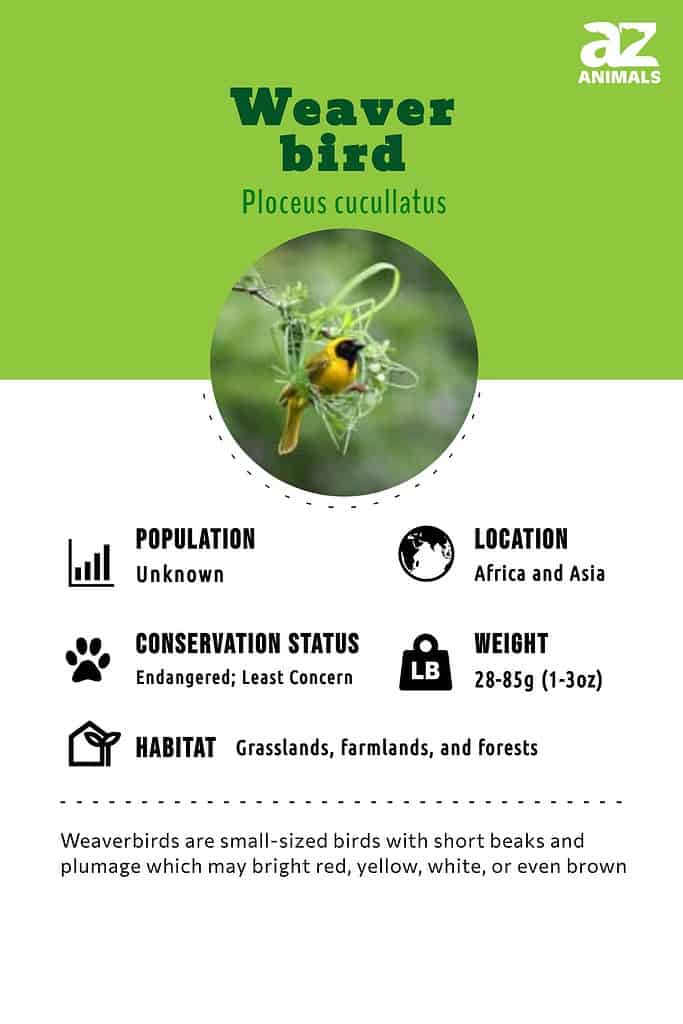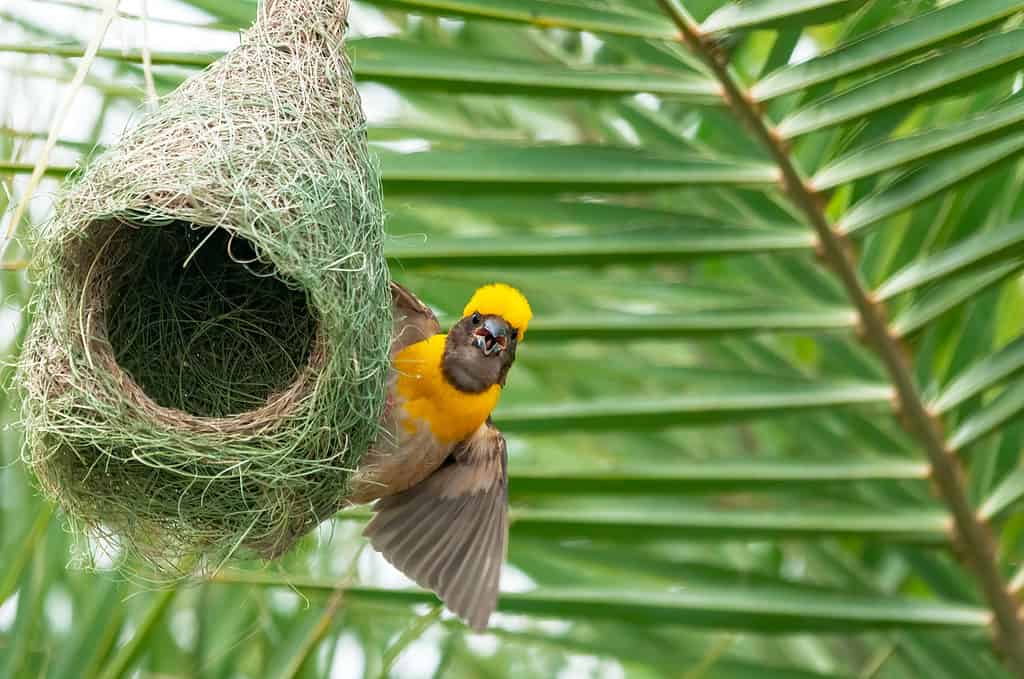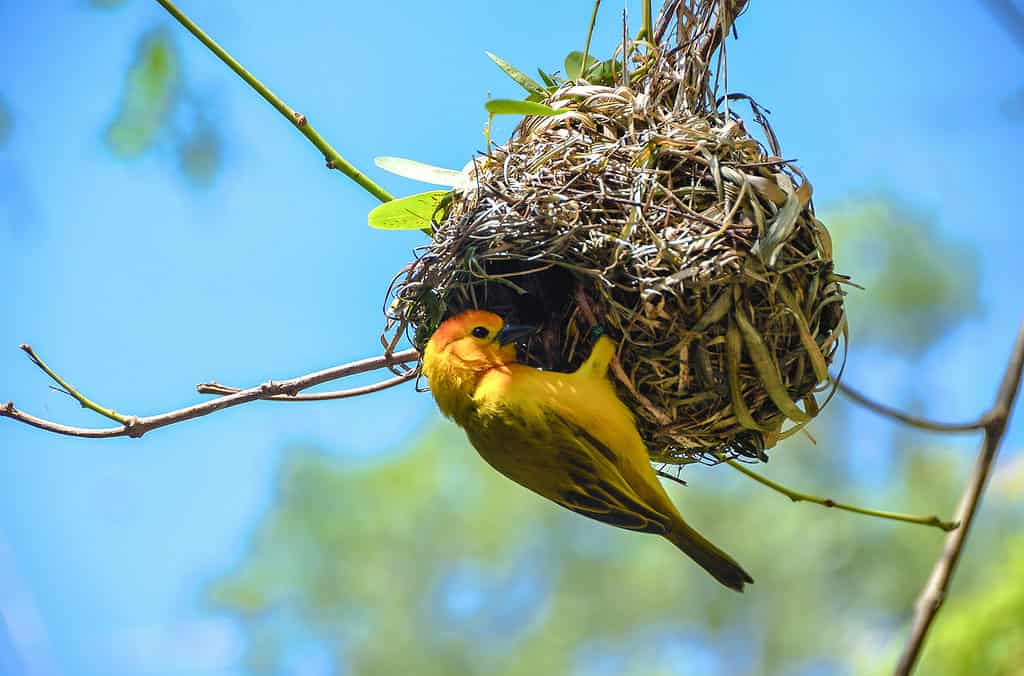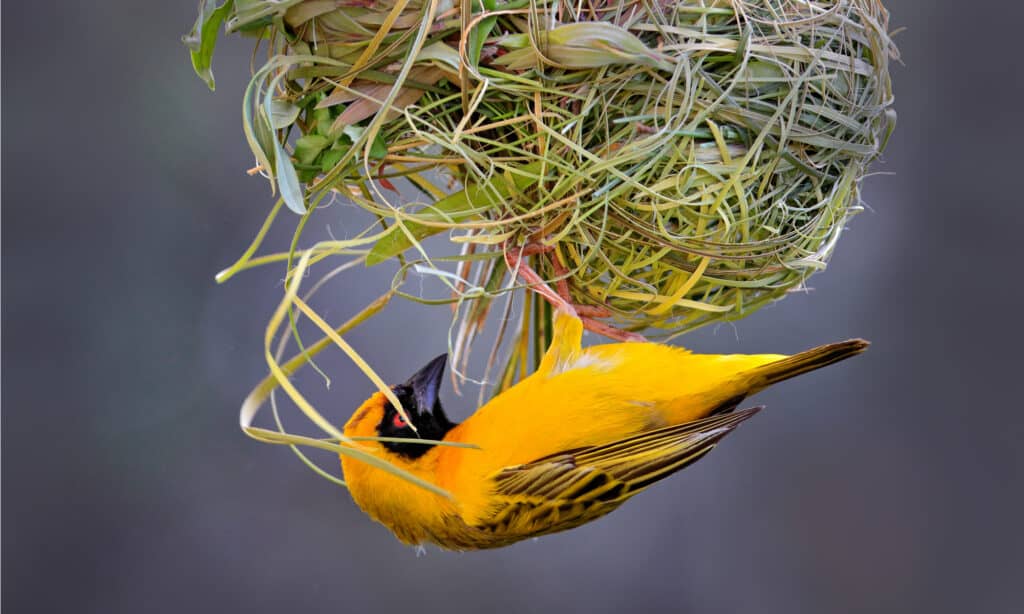Weaver Bird
Ploceus cucullatus
The weaver constructs an elaborate nest for the breeding season
Advertisement
Weaver Bird Scientific Classification
- Kingdom
- Animalia
- Phylum
- Chordata
- Class
- Aves
- Order
- Passeriformes
- Family
- Ploceidae
- Genus
- Ploceus
- Scientific Name
- Ploceus cucullatus
Read our Complete Guide to Classification of Animals.
Weaver Bird Conservation Status
Weaver Bird Facts
- Prey
- Seeds, grains, insects, frogs, and other animals
- Fun Fact
- The weaver constructs an elaborate nest for the breeding season
- Estimated Population Size
- Unknown
- Biggest Threat
- Habitat loss
- Most Distinctive Feature
- Some species grow bright yellow or red feathers for the breeding season
- Other Name(s)
- Malimbes, weaver finches, and weaverbirds
- Wingspan
- 20-38cm (8-15in)
- Incubation Period
- A few weeks
- Habitat
- Grasslands, farmlands, and forests
- Predators
- Lizards, snakes, crows, and birds of prey
- Diet
- Omnivore
- Type
- Bird
- Common Name
- Weaver
- Location
- Africa and Asia
- Average Clutch Size
- 5
- Nesting Location
- Thorny trees
- Age of Molting
- A few weeks
- Migratory
- 1
View all of the Weaver Bird images!
True weavers have the amazing ability to build complex nests in the breeding season.
The weaver is a family of songbirds originating from Africa and Asia. While not all members of this family are technically called weavers, most of them do construct elaborate nests and breed together in sizable colonies. These nests are some of the most amazing constructions in the entire avian world. There are many different types of weavers, each with their own unique nests.
3 Weaver Amazing Facts
- Weavers are said to be very smart birds that can be trained to perform tricks and stunts.
- Weavers have the ability to hang upside down from just about any surface or object they can cling to with their talons.
- Some species are dedicated “social parasites” that lay their eggs in the nest of another weaver species. The new parents are then tricked into raising the chick as their own.

Where to Find the Weaver
Weavers are endemic to grasslands, forests, and savannas throughout sub-Saharan Africa and South Asia. A few species have been introduced outside of their original range as well.
Nests
The one quality that unites together all weavers is their ability to construct big nests from grass, leaves, and other plant fibers. These nests can range from simpler roofed shelters to complex cylindrical structures comprised of a single tube-shaped entrance and an internal chamber. Suspended from a thorny palm or acacia tree over a body of water, the nest is constructed by the male in the breeding season with only his feet and beak to work with. Weaver nests vary in both size and shape. The social weavers of southwestern Africa construct giant communal nests that reach a height of around 10 feet.
Scientific Name

Weaver birds belong to a vast family of over 100 species which derive their name from the ancient Greek word for weaver
©Mogens Trolle/Shutterstock.com
The scientific name for the weaver family is Ploceidae. It is derived from the ancient Greek word plokeus, meaning weaver. The family also includes bishops, widowbirds, and queleas, but weavers make up the bulk of the species. The genus Ploceus is the most populous with some 60 or so species alone.
Size, Appearance, and Behavior
Weavers come in a remarkable variety of different shapes and colors. These are small songbirds, rarely measuring much more than 5 to 10 inches from their rounded head to square tail. The plumage is perhaps the most interesting and diverse characteristic. Bright red, yellow, black, gray, brown, and white, arranged in different patterns and shapes, are all very common plumage colors. The male weavers from the genus Ploceus are particularly notable for their ability to grow bright yellow plumage in the breeding season.
Weavers are among the most gregarious (meaning social) birds in the world. They often nest together in large colonies that consist of dozens of members at a time. The red-billed quelea is particularly extraordinary in this regard; it has been seen occupying massive colonies over many square miles in which millions of birds are supposedly said to reside. Weaver birds do almost everything in close proximity to each other, including foraging, breeding, and preening. When they travel together, some species also fly in a tight formation. Their high-pitched chattering calls include mating songs, alarm calls, and chick cries.
Types
There are 122 species of weaver birds.
The most common of them include:
- The village weaver: This gregarious species is generally found in Africa and is known for its males which have a bright yellow plumage streaked with black and black head feathers. Females have feathers of a more muted yellow interspersed with pale brown. The species is at home in the woods and among humans too.
- The cinnamon weaver: This avian is rather fond of trees with copious foliage and can be found in Sudan and South Sudan. It is found nowhere else.
- The white-headed buffalo weaver: This species is known for the dark bands around its eyes, dark wing and tail feathers, and white chest and head feathers. It is especially fond of buffalo since it gets to feed on the insects they disturb.
- The southern masked weaver: This species is known for its prolific nest building (males build about 25 per season). It is also one species capable of outwitting the cuckoo due to its habit of laying different colored eggs. Strange eggs are jettisoned from the nest.
- The chestnut weaver: In a departure from the golden plumage of most weavers, male members of this species have a black mask and russet head and chest feathers. Chestnut weavers live in eastern and south-western Africa.
Evolution

The earliest ancestor of weaver birds is believed to have emerged during the Miocene, about 18 million years ago
©Karel Gallas/Shutterstock.com
The ancestor of the weaver bird is believed by paleontologists to have lived during the early part of the Miocene. During this epoch which occurred between 5.33 – 23 million years ago and also saw apes emerge on the evolutionary scene, the climate was warm although cooling gradually.
The earlier version of the weaver bird was likely pretty similar to its descendants in appearance since several animals and birds during the Miocene resembled their distant progeny.
Migration Pattern and Timing

Weaver birds generally migrate in large groups
©NiceClicks/Shutterstock.com
Weaver birds generally don’t migrate far, but many types of species do travel seasonally in response to changing weather and food availability. They generally migrate together as a large flock.
Diet
The weaver is an omnivorous bird that spends much of its day foraging on the ground and in trees.
What does the weaver eat?
The diet of the weaver mostly consists of seeds, grains, insects, and other small animals. Their large beak enables them to crack open the thick shells on which they feed. Because of their habit of raiding farmlands and fields, some weavers are considered to be annoying agricultural pests.
What eats the weaver?

Crows as well as larger birds of prey are known to hunt weavers
©U.S. Fish and Wildlife Service / public domain – License
Many weavers are preyed upon by snakes, lizards, crows, and larger birds of prey. The location of the nest, suspended from a thorny tree over a body of water, can provide protection against predators. Mobs of weavers may also work together to drive the predator away.
Predators, Threats, and Conservation Status

According to the IUCN, weavers are doing pretty well in general. However, a few species are endangered
©iStock.com/Syed F Abbas
The weaver varies considerably in its conservation status. According to the IUCN Redlist, the majority of species are considered to be least concern, meaning they require no specific conservation effort. A few of them are endangered too, including Finn’s weaver and the golden-naped weaver. Habitat loss is a persistent threat for some species, but they can adapt fairly well to human presence.
Reproduction, Young, and Molting

Female weaver birds assess the quality of potential mates’ nests as a means of deciding whether to accept their advances or not.
©iStock.com/thittaya itthithepphana
The weaver bird has many different reproductive strategies. Many species gather together in large communal flocks to attract a mate. Males produce a chattering bird song while fluttering their wings. Females will judge the male by the quality of his nest, so not everyone will have immediate success. Many nests are abandoned without use in the breeding season (although this may also be an anti-predator strategy). After a few weeks of incubation inside the nest, the eggs will start to hatch. With rigorous feeding and care from the parents, the chicks will gain their flight feathers and start to leave the nest only a few weeks later. Both parents are generally polygamous, meaning they might have multiple mates per breeding season. The lifespan varies, but many of these birds live some 10 to 20 years long.
Population

Reliable population estimates remain unavailable for several weaver species
©Ondrej Prosicky/Shutterstock.com
Good population estimates are not available for the majority of species, but there are some exceptions. The vulnerable bannerman’s weaver has some 6,000 to 15,000 mature individuals remaining in the wild. The giant weaver has anywhere between 2,500 and 10,000 mature individuals remaining. The endangered Finn’s weaver has less than a thousand mature individuals remaining. Many other species are likely to have a similar population range.
Full Species List
Here are the 122 species of weaver birds:
- Aldabra fody
- Asian golden weaver
- Baglafecht weaver
- Bannerman’s weaver
- Bar-winged weaver
- Bates’s weaver
- Baya weaver
- Bertram’s weaver
- Black bishop
- Black-billed weaver
- Black-breasted weaver
- Black-capped social weaver
- Black-chinned weaver
- Black-headed weaver
- Black-necked weaver
- Black-winged red bishop
- Blue-billed malimbe
- Bob-tailed weaver
- Bocage’s weaver
- Brown-capped weaver
- Cape weaver
- Cardinal quelea
- Cassin’s malimbe
- Chestnut weaver
- Chestnut-and-black weaver
- Chestnut-backed sparrow-weaver
- Chestnut-crowned sparrow-weaver
- Cinnamon weaver
- Clarke’s weaver
- Comoros fody
- Compact weaver
- Crested malimbe
- Dark-backed weaver
- Donaldson Smith’s sparrow-weaver
- Eastern golden weaver
- Fan-tailed widowbird
- Finn’s weaver
- Fire-fronted bishop
- Forest fody
- Fox’s weaver
- Giant weaver
- Gola malimbe
- Golden palm weaver
- Golden-backed bishop
- Golden-backed weaver
- Golden-naped weaver
- Grey-capped social weaver
- Heuglin’s masked weaver
- Holub’s golden weaver
- Ibadan malimbe
- Jackson’s widowbird
- Juba weaver
- Katanga masked weaver
- Kilombero weaver
- Lesser masked weaver
- Little weaver
- Loango weaver
- Long-tailed widowbird
- Lufira masked weaver
- Marsh widowbird
- Mauritius fody
- Maxwell’s black weaver
- Montane widowbird
- Nelicourvi weaver
- Northern brown-throated weaver
- Northern masked weaver
- Northern red bishop
- Olive-headed weaver
- Olive-naped weaver
- Orange weaver
- Preuss’s weaver
- Principe weaver
- Rachel’s malimbe
- Red fody
- Red weaver
- Red-bellied malimbe
- Red-billed buffalo weaver
- Red-billed quelea
- Red-collared widowbird
- Red-cowled widowbird
- Red-crowned malimbe
- Red-headed malimbe
- Red-headed quelea
- Red-headed weaver
- Red-vented malimbe
- Rodrigues fody
- Rufous-tailed weaver
- Rüppell’s weaver
- Ruvu weaver
- Sakalava weaver
- Sao Tome weaver
- Scaly-feathered weaver
- Seychelles fody
- Slender-billed weaver
- Sociable weaver
- Southern brown-throated weaver
- Southern masked weaver
- Southern red bishop
- Speckle-fronted weaver
- Spectacled weaver
- Speke’s weaver
- Strange weaver
- Streaked weaver
- Tanzanian masked weaver
- Taveta weaver
- Thick-billed weaver
- Usambara weaver
- Vieillot’s black weaver
- Village weaver
- Vitelline masked weaver
- Weyns’s weaver
- White-billed buffalo weaver
- White-browed sparrow-weaver
- White-headed buffalo weaver
- White-winged widowbird
- Yellow bishop
- Yellow-capped weaver
- Yellow-crowned bishop
- Yellow-legged weaver
- Yellow-mantled weaver
- Yellow-mantled widowbird
- Zanzibar red bishop
Weaver Bird FAQs (Frequently Asked Questions)
Does the weaver migrate?
The weaver does tend to migrate seasonally every year with the rainy seasons.
How many eggs does the weaver lay?
The number of eggs can vary from species to species, but they can generally produce up to five eggs at a time.
How fast does the weaver fly?
The weaver’s flight speed varies from species to species.
What is the weaver’s wingspan?
Most weavers have a wingspan between 8 and 15 inches long.
When do weavers leave the nest?
Most weaver chicks will leave the nest after only a few weeks.
What is a weaver bird?
The weaver is a family of songbirds from Africa and Asia with the amazing ability to construct complex nests. There are many different types of weavers, each with its own unique appearance, behavior, and nest style.
What does a weaver bird nest look like?
The nest often looks like an upside-down flask, according to the Encyclopedia Britannica. It often has a bottom entrance that leads up through a tube in the nest.
What is special about a weaver bird?
It constructs some of the most elaborate nests in the entire bird world.
Why do weaver birds destroy their nests?
The nests are only intended to be temporary constructions for the breeding season.
How do weaver birds make their nest?
They literally weave together overlapping leaves, grass, and other plant fiber.
Are tailorbird and weaver bird the same?
The tailorbirds are not related to the weavers at all. They belong to an entirely separate family called Cisticolidae. But like the weaver, they do have the ability to construct a complex nest. Tailorbirds actually pierce the edges of leaves and sow them together with plant fiber or spider webs to create a kind of cradle.
Thank you for reading! Have some feedback for us? Contact the AZ Animals editorial team.
Sources
- , Available here: https://www.britannica.com/animal/weaver-bird
- , Available here: https://www.10000birds.com/weavers.htm

















